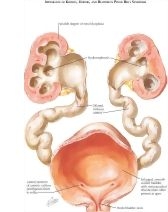Prune belly syndrome
The prune belly syndrome (PBS ), also called Bauchdeckenaplasie syndrome, is a congenital malformation syndrome. It is characterized by a triad consisting of lack of abdominal muscles, severe malformations of the urinary tract and bilateral cryptorchidism (only for boys).
Meaning of the name and medical history
Prune belly syndrome is a term of English origin and means roughly translates to " prune belly syndrome " or " prune belly syndrome " ( prune engl. "Back " or " prune " and belly to "belly" ). To a dried plum, the abdomen of affected people is the wrinkled appearance similar meant, which is caused by the malformation of the abdominal muscles. In addition, there are some other synonyms such as Obrinsky -Fröhlich syndrome, named after Franz Fröhlich and William Obrinsky or Eagle - Barrett syndrome named after George S. Barrett and JF Eagle.
Franz Fröhlich 1839 described in the first case in which a failure of the abdominal musculature was observed. Other malformations, such as occur during typischwerweise prune belly syndrome, have not been described. RW Parker described the 1895 case of a patient in which cryptorchidism was in addition to the absence of the abdominals detectable. This was followed by many other publications, including the Eagle and Barrett, who had described 9 cases.
Frequency
The incidence of the disease is between 1:30,000 and 1:50,000 live births. Boys are affected compared to girls much more frequently. Only 3-10 % of those affected are girls. In the medical literature there are over 200 case reports.
Clinical picture
After the birth of the characteristic gefältete belly is striking. The wrinkling is caused by hypoplasia of the abdominal wall muscles. In boys, testicles have not descended into the scrotum to palpate ( cryptorchidism ). The testicles are usually in the abdominal area ( intra-abdominal ). In addition, abnormalities of other organs or organ systems may be evident. The skeletal system may be affected in the form of clubfoot, a congenital joint stiffness ( arthrogryposis multiplex congenita ), hip dislocation, hip dysplasia and Vielfingrigkeit. It can occur malformations of the gastrointestinal tract, such as malrotation, imperforate anus, gastroschisis and omphalocele. Other possible malformations are a Lungendysplasie and malformations of the cardiovascular system in about 10 % of cases, especially atrial and ventricular septal defects and tetralogy of Fallot.
Diagnostics
Even before the birth can be detected by means of ultrasound extensions of the urinary tract and abdominal wall irregularities. The demarcation caused by the renal Harnwegserweiterung from other causes such as a vesikorenalem reflux or urethral valves is difficult.
Cause
The cause of prune belly syndrome is unknown. We discuss several causes.









